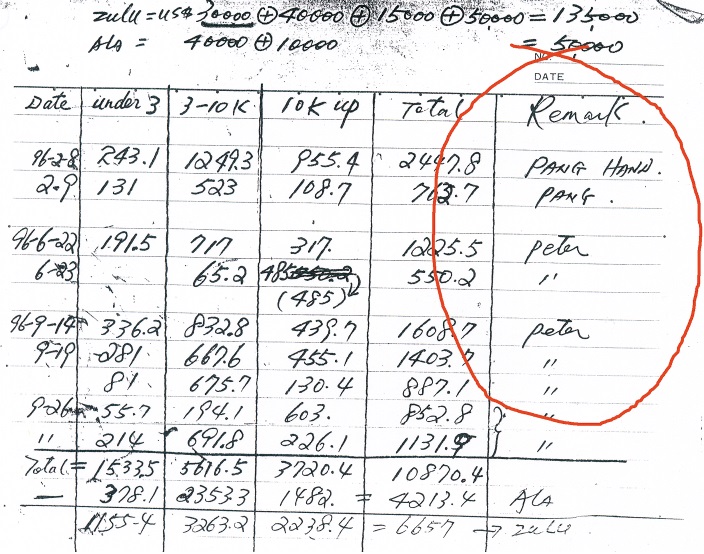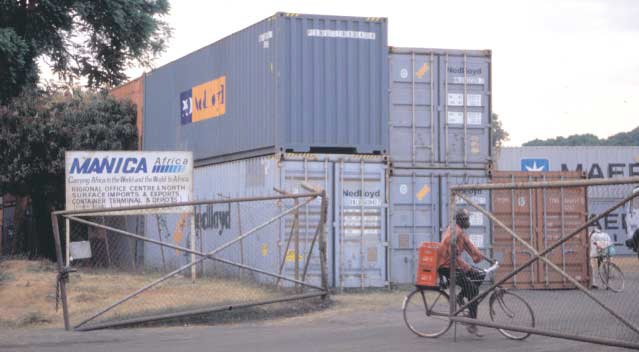Intelligence Week: How we put the pieces together in the landmark ‘Singapore seizure’ ivory case



The creative use of intelligence has always been at the heart of EIA’s investigations and campaigning – the ability to make sense of reams of information and build up a clear picture of the networks involved in various forms of environmental crime has been vital in solving cases and building support for enforcement and legislative action.
In the digital age we live in, unprecedented amounts of information flow around us and complex systems and software are now used by EIA to make sense of data derived from our complex investigations (human intelligence, or HUMINT) and open source intelligence (OSINT) such as social media scraping and publicly available databases such as company registries.
To illustrate how EIA uses intelligence, I want to focus on a case involving a huge ivory seizure in 2002, back in the mists of time before mobile phones were smart and when Facebook would not be founded for another two years. A different world before computers, when we were reliant on more physical intelligence-gathering.

Some of the ivory discovered in the ‘Singapore seizure’ of 2002 (c) Singapore Agri-Food and Veterinary Authority (AVA)
Yet despite the technological changes, the key principles used to investigate the ivory case 18 years ago still hold true. Behind the morass of false information and aliases used by criminal networks, there is always a pattern which analysis of intelligence can reveal. Criminals using front companies, banks and moving contraband in shipping containers occasionally have to tell the truth in official documents. Finally, criminals, like anyone, make mistakes when filling out paperwork.
It was Spring 2002 when a fax arrived at EIA’s London office from a law enforcement contact in Zambia. It was a hand-drawn chart showing connections between various individuals which the contact believed were part of a network poaching elephants in Zambia and smuggling the tusks across the border into neighbouring Malawi before onward shipment to the Far East.
The main hub of the network appeared to be a crafts factory in Lilongwe, the Malawian capital. The source had turned to EIA due to concerns that corruption was impeding actions against the network.
It was an intriguing tip-off but lacking in hard evidence and difficult to research remotely, so the contact agreed to keep in touch and let us know of further developments.
In June, we had the tangible lead we needed to start investigating and disrupting the network. The contact provided details of a shipping container bound for Singapore which he believed carried a consignment of ivory sent by the syndicate. He provided crucial information from the Bill of Lading, including the container number, vessel, name of the shipper and consignee in Singapore plus the description of the contents – six wooden boxes containing stone sculptures.
The vessel was due to arrive in a few days. EIA informed INTERPOL and on 28 June, when the container was offloaded, officers from Singapore customs inspected the contents and found 6.2 tonnes of ivory tusks packed into wooden crates. It was the biggest haul of ivory sized since the international ban on the ivory trade in 1989.
I was in southern China at the time, documenting the increasing availability of ivory on the market there, and the next day took a flight to Singapore to start digging into the intended recipients of the ivory.
My first port of call was to meet with Government officials involved. I had hoped to get more details of the shipment, but it turned out to be a rather cursory meeting. I asked whether any action would be taken against the company listed as the consignee, called Delight Harvest. I was told that one of the directors of the company had been interviewed and claimed the company name had been used on the shipping documents without his knowledge and denied any involvement. The authorities appeared to believe him and it was case closed.
Left with an afternoon to kill in Singapore, I headed to the office of the Singapore Registry of Companies and Businesses to delve more deeply into Delight Harvest. At the front desk I asked for the company’s records and was given an envelope containing microfiche slides and pointed towards a reader. It was tedious work scrolling through the slides dating back to the company’s formation in 1991 and nothing obviously suspicious jumped out.
I decided to do further research into the directors of Delight Harvest and found that one of them was also a director of another company in Singapore called Kyomi Handicraft and Trading, which piqued my interest as the main base of the network in Malawi was also a crafts factory. So I returned to the front desk, got the microfiche records for Kyomi and discovered that two of that company’s directors had listed their occupation as “ivory craftsman”. They were also directors of another company – Fung Ivory. All three companies had the same registered address, secretary and auditor. Protestations of innocence by Delight Harvests’ owners were looking more dubious.
The company records also showed that several of the directors had moved from Hong Kong, then a major ivory trading centre, to Singapore in the late 1980s when setting up the companies linked to Delight Harvest. I recalled that EIA had done a series of investigations into the Hong Kong ivory trade around that time, so as the registry was about to close I headed back to my hotel and called the office in London. A colleague went through the relevant trip reports and discovered that three of the names my research had uncovered were formerly lieutenants for the notorious Poon family syndicate based in Hong Kong, which used various loopholes in the ivory trade system prior to the 1989 ban to amass a fortune built on poached ivory.
I had started the day with just the name “Delight Research”. Open source intelligence had led to a picture emerging of a group of Hong Kong ivory traders who had shifted operations to Singapore in the late 1980s, about the time of the ivory ban, and were still involved in ivory trafficking.
I suspected the syndicate stretching from southern Africa to Singapore had made many successful shipments prior to the seizure. It was time to start probing into the supply side in Malawi, focusing on the factory in Lilongwe.
When my colleague Mary Rice and I arrived in Lilongwe, we paid a visit to a contact at the Anti-Corruption Bureau, one on the Government agencies looking into the ivory trafficking case. After we explained the findings from the Singapore intelligence he was willing to share information. He had been busy gathering a plethora of shipping documents relating not only to the shipment seized in Singapore but to all shipments bound for the Far East which used the same freight company in Lilongwe, suspecting that the syndicate had an insider working to arrange the logistics for its containers. It was a huge stack of papers which took an hour to photocopy.

Page from Allena notebook detailing the sale of over 10 tonnes of ivory between February and September 1996
Upon returning to London, the task of analysing the intelligence undoubtedly buried in the paperwork began. Documents for the seized shipment yielded fresh evidence and confirmed some of the findings from the Singapore trip. A currency declaration form relating to the shipment had been signed by one of the directors of Kyomi Handicraft. Although Seng Luck, the name of the company in Lilongwe which sent the shipment, was fake, buried in the file was a customs declaration form with the name Allena Transport as the shipper, which had mistakenly been entered. Allena Curios was the name of the factory in Lilongwe suspected of being the hub for collating ivory smuggled from Zambia and onward shipment.
A grid was then drawn up and the key information from the scores of suspicious shipments, such as shipper, consignee, shipping line, description of the goods and the date. Through painstaking analysis of the patterns, the EIA team was able to conclude that the consignment seized in Singapore was just the tip of the iceberg; the syndicate had made at least 19 previous shipments of ivory since 1994, 15 of which went to Singapore.
Intelligence analysis had revealed a prolific ivory trafficking syndicate of breath-taking scale, with its origins dating back to the early 1980s.
One piece of the puzzle remained to be solved. Sources close to the case repeatedly mentioned a man called Peter Wang as being the head of the group and he was even named in the press as being the “mastermind” behind the syndicate. Yet his real identity remained elusive; a string of aliases were used in the documents, such as Onn, Peter S Wong and Pang.

Manica Freight Company, Lilongwe, Malawi was involved in transporting shipments for Allena (c) EIAimage
Buried in the shipping documents was a vital clue, a courier company document faxed to “Peter Wang” and giving the address as a flat in Kowloon, Hong Kong. It was used to despatch a shipping bill of lading, which has to be physically presented to clear cargo. Suspecting that amid all of the false trails this had to be a real address used by him, I did a search of the Hong Kong Land Registry – and there was his real name.
While I have used an old case to demonstrate the central role intelligence plays in EIA’s work, it is not a cold case. Remnants of the “Wang” network and its antecedents remain involved in ivory trafficking. For example, in 2013 a Malawian national called Charles Kaunda was arrested near the border with Tanzania driving a truck with 2.6 tonnes of ivory tusks concealed beneath bags of cement. Our investigations show that Kaunda had previously worked as a driver for the syndicate’s main coordinator based in Malawi.
EIA continues to investigate similar wildlife trafficking syndicates and the Intelligence Team is central to that work. Although software may be used now to help visualise links, the message is the same – conducting intelligence-led investigations is key in disrupting transnational organised crime groups and combatting environmental crime.